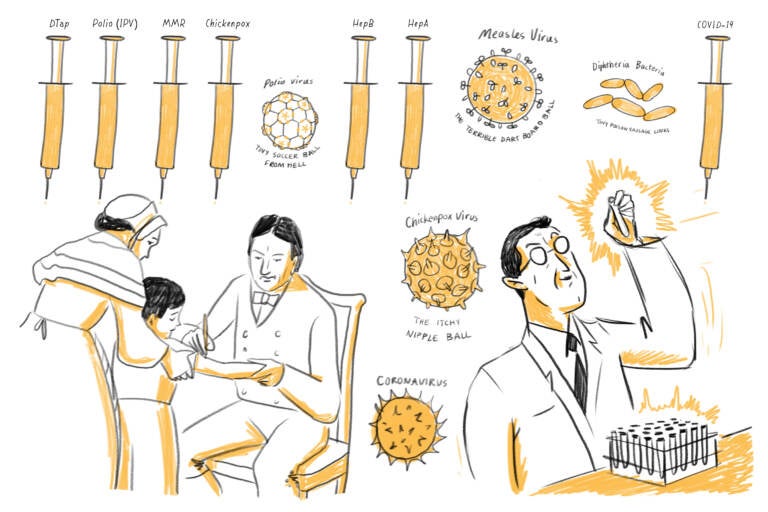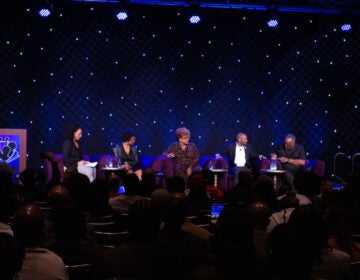Should schools require the COVID vaccine? Many experts say it’s too soon

A look at the history of vaccines in schools. (LA Johnson/NPR)
The vaccination of children ages 5 to 11 against COVID-19 is well under way: The White House announced this week that an estimated 10 percent of children in that age group have received their first shot.
California has become the first state to announce that it will add this vaccine to its list of the shots required for all school children. And a handful of districts in 14 states are making similar moves, starting with mandates for student-athletes to participate in sports.
Because almost every child attends school, vaccine mandates have been uniquely effective against diseases like smallpox, polio, pertussis, and most recently chickenpox. But school mandates have also always brought pushback — and that has intensified to a new level in the 21st century.
“Vaccines have been controversial since the very first vaccine was developed against smallpox,” says Elena Conis, a historian of medicine at the University of California, Berkeley. “And vaccination became increasingly controversial when states began to make it mandatory.”
Here’s a whirlwind tour of the past, present and future of vaccine mandates, with some surprises along the way.
1. The first school vaccine mandates date back more than 200 years
In 1818, the King of Wittenberg, in east-central Germany, issued what appears to have been the first school vaccination requirement, for smallpox. The king decreed: “No person to be received into any school, college or charitable institution; be bound apprentice to any trade; or hold any public office, who has not been vaccinated.” In 1827, Boston became the first city in the United States to do the same. As the country became more urban toward the end of the 19th century, vaccine requirements increased, and mortality rates from smallpox plummeted.
2. The first vaccine mandates gave rise to the first anti-vaccinationists.
In 1882 the Anti-Vaccination League of America held its first meeting in New York. Among the false assertions made by speakers at the meeting was the idea that smallpox was spread by dirt, not germs. Just as they do today, 19th-century anti-vaccinationists professed doubt in science, faith in religion, and zeal for personal liberty. They made common cause with a range of other outside-the-mainstream groups, like temperance advocates, vegetarians, homeopaths, phrenologists and palm readers. They championed unfounded alternatives to vaccination, like homeopathic remedies; and made false claims, such as that vaccines caused eczema.
Conis points out that there were real cases of vaccine injuries in the 19th century that contributed to doubts: “Vaccination was carried out in a couple of different ways, sometimes with a matter taken from livestock, in particular cows, and sometimes done in a procedure called arm-to-arm,” where one person’s blister from vaccination would be used to vaccinate the next person. “And both of these methods could sometimes transmit other infections, like tetanus and syphilis.”
3. The Supreme Court upheld school vaccine mandates a century ago.
The key U.S. Supreme Court ruling on school vaccine mandates came in the 1922 case Zucht v. King. “The court was very clear: This is not a liberty violation,” says James Hodge, a professor of law at Arizona State University and a member of the Network for Public Health Law. “This is not a constitutional issue. States and localities can impose school vaccination requirements, period. And as a result, we saw obviously 80-plus more years of schools doing exactly that through state law.” Hodge has been tracking legal challenges to COVID vaccine mandates.
4. The polio vaccine wasn’t mandated for years after it was introduced in 1955.
“When the polio vaccine was first approved, loads and loads of people showed up to get it for themselves, for their children,” says Conis. “And it was several years before states even considered mandates to require that vaccine for children.”
5. Since 1979, Mississippi has banned religious and personal belief exemptions to school vaccine mandates, and the state has the highest rate of childhood vaccinations in the U.S.
West Virginia, too, has allowed only medical exemptions since it passed its first statewide compulsory vaccination law way back in 1905. California, Connecticut, Maine and New York followed suit in the 2010s, eliminating nonmedical exemptions in response to measles outbreaks that followed from a rise in people opting out of vaccines.
6. In 1980, 28,000 New York City students were excluded from school after failing to get their measles shots.
It was one thing to put state laws on the books requiring vaccinations; it was another thing for schools to enforce them. In 1977, during a measles epidemic in Los Angeles, it was estimated that only two-thirds of lower-income children nationwide were actually vaccinated for the disease. Excluding children from school, as New York City did, was a last resort. Throughout the second half of the 20th century, outbreaks led in turn to crackdowns on one hand, and public immunization campaigns on the other.
7. The World Health Organization named “vaccine hesitancy” as one of the 10 most notable threats to global health — back in 2019.
Although opposition to vaccine mandates is as old as the mandates themselves, scholars agree that the 21st-century movement has been different. That’s partly because of the ease of spreading misinformation on social media. It’s also partly because of the emotional weight of the opposition, argues Dorit Reiss, a professor at the University of California’s Hastings College of Law.
“Parents of children with autism were pulled into the anti-vaccine movement. The anti-vaccine movement offered support, offered them an explanation for how their children became autistic, offered them cures — fake cures, but cures,” Reiss says. “It created a very strong core group of people who believed passionately that it was the vaccines [that caused their children’s autism], and the movement got more organized, more institutionalized.”
8. Adding new vaccines to the school mandate list has proven difficult in the 21st century.
All 50 states currently require schoolchildren to be immunized for polio, smallpox, MMR (measles, mumps and rubella), Tdap (tetanus, diphtheria, pertussis), and varicella. Varicella (chickenpox) is the newest, making the list in the early 2000s, according to the Immunization Action Coalition.
But only a handful of states require rotavirus, flu, or HPV vaccines for school. Because of its association with sexual activity, the HPV vaccine has been especially controversial. “One of the last vaccines we attempted to mandate for kids was the HPV vaccine,” says Elena Conis at Berkeley. “That didn’t go so well. And we’re in a much more polarized moment with respect to vaccination now than we were back then.”
9. In light of history, especially recent history, many public health experts and vaccine historians say it’s not yet time for school vaccine mandates for COVID.
“I would say in the next three to six months, encouraging a self-directed push to get people to vaccinate their their kids is probably what will help it to not be so ‘line in the sand,’ ” says Dr. Stella Safo, founder of Just Equity for Health, a New York City-based health care company that focuses on equitable care delivery. “And then I think down the line, just as we’ve mandated that you have to be vaccinated against chickenpox before you can go to school, I think COVID will eventually be added to that portfolio. ”
“My view is still that mandates are premature,” says Reiss. “But I want to make it clear … I’m making my recommendation a little bit from the ivory tower, and the people on the ground may have a very different perspective.”
“I don’t think that it would be the right time to [mandate the COVID vaccine at a state level], especially if we look in the context of the entire pandemic,” says Dr. Thomas Dobbs, Mississippi’s state health officer. “Patients trust their own physician more than anybody else and especially where we are right now in the pandemic, that’s the best place for that conversation.”
9(MDAzMzI1ODY3MDEyMzkzOTE3NjIxNDg3MQ001))




